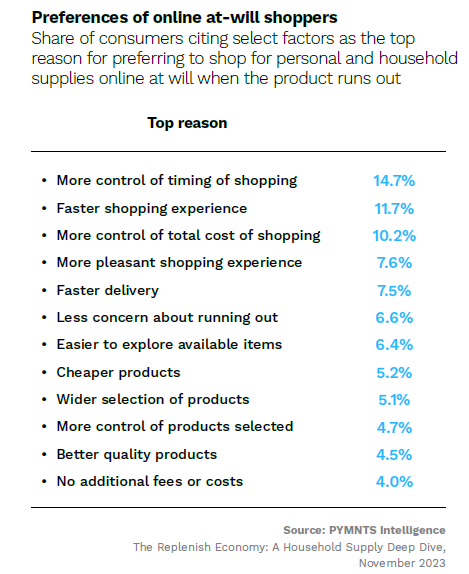15% of Consumers Buy Online to Control Time Spent Shopping

Online retail subscriptions have revolutionized the way consumers shop, providing convenience and personalized experiences that cater specifically to individual preferences and needs.
This shift in shopping habits presents an opportunity for online merchants to capitalize on evolving consumer expectations by innovating with retail subscription offerings, as detailed in “The Replenish Economy: A Household Supply Deep Dive” PYMNTS Intelligence study, produced in collaboration with sticky.io.
According to the report, the rise of retail subscriptions has led to a reduction in in-store shopping. Approximately 42% of retail subscribers shop less frequently at physical stores due to their current subscriptions, highlighting the importance for online retailers to create flexible and engaging online subscription experiences.
Millennials are at the forefront of this shift, with four in 10 of them relying on retail subscriptions for most or all of their shopping needs. This generation leads the adoption of retail subscriptions, with 39% of millennial subscribers making most or all of their purchases through scheduled subscriptions. Against this backdrop, it is crucial for retailers to cater to millennials’ preferences and expectations when designing subscription offerings.
The study also emphasizes the significance of service quality in retaining subscribers. A negative experience or poor service can drive away otherwise loyal customers. For instance, the report reveals that 17% of subscribers using scheduled and auto-refill subscriptions would cancel their subscription if the merchant could not provide a refund for a disliked item.
Flexibility and control are key factors in attracting and retaining customers. As the study shows, a significant share of retail subscription merchants (74%) have leveraged this trend by allowing current subscribers to change their plans at will. This strategic move not only amplifies the prospects of meeting individual preferences but also fosters enduring loyalty, solidifying their customer base for the long haul.

Further data analysis shows that among online at-will shoppers, control over timing emerges as the top reason for preferring to shop online, cited by 15% of shoppers. This significantly outweighs the 5% of in-store shoppers who consider timing as their primary reason for shopping in person. Additionally, 10% and 12% of at-will online shoppers emphasize control of costs and a faster shopping experience, respectively, as their main motivations.
In conclusion, the rise of online retail subscriptions has reshaped consumer shopping habits. And to attract and retain subscribers in this evolving retail landscape, online merchants must prioritize service quality, offer flexibility, and cater to consumer preferences for timing. By doing so, they can capitalize on the convenience and tailored experiences offered by retail subscriptions.

